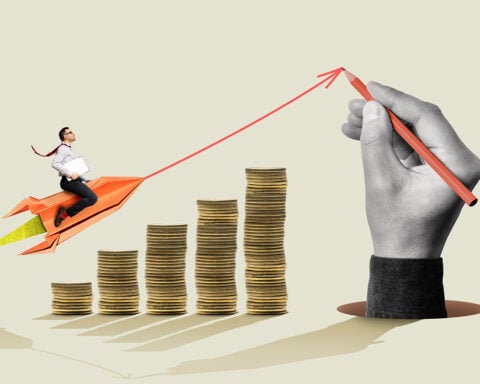As the economy continues to navigate choppy waters, with stocks fluctuating wildly and inflation proving stubbornly persistent, it can be challenging to stay optimistic.
Nevertheless, the turbulent market also presents fresh opportunities (alongside certain risks) for investors, according to some financial analysts.
Current Situation: Global economic stability remains fluid, with the labour market exhibiting remarkable resilience even as other metrics, such as consumer spending and manufacturing, show signs of weakening. Moreover, ongoing turmoil in Russia could trigger another inflationary wave if it disrupts its extensive commodity exports.
Not long ago, central banks were pausing or winding down their sustained rate hikes to combat inflation. However, recent signals from policymakers warn investors of further financial discomfort.
Amidst all this, US stocks have clawed their way up from a bearish market to a bullish one. However, market observers are cautious, suspecting this could be a temporary recovery disguised as a bull market. Last week saw a significant drop, ending a streak of weekly gains.
Despite the uncertainties, Indrani De, Head of Global Investment Research at FTSE Russell, maintains solid grounds for investor optimism, citing signs of a rekindled appetite for risk in the macroeconomic environment.
In an interview with Before the Bell, De provides her insights on the market:
Q: What are your thoughts on inflation and bond yields?
Indrani De: Although inflation remains high, its trajectory is the critical factor, and it is decisively moving towards disinflation. Different countries are at varying stages of their inflation cycles, causing a dispersion among asset classes and countries, necessitating selectivity among investors.
The second point I’d like to highlight is the resilient economic growth in the US, leading to increased earnings forecasts. Stocks have performed exceptionally well following the recent fall of the US dollar from its 2022 Q4 highs. A weakened dollar bodes well for riskier assets and large-cap stocks.
The market is often overly focused on short-term policy rates. However, the longer-term rates, like the 10-year Treasury yield, are most critical for equities and other risk assets. After peaking in early 2022, this rate has reduced slightly and stabilized, sparking a resurgence in tech stock growth.
Q: What impact does artificial intelligence (AI) have on the markets?
Indrani De: It’s not just cyclical factors such as GDP resilience and upward corporate earnings revisions. There’s also a real hope that AI could trigger a structural boost to our economic growth prospects, much like the internet boom of the 1990s impacted the entire economy.
We’re just at the dawn of AI’s integration into the economy. It starts with certain companies reaping the benefits, but eventually, I foresee AI becoming universally accessible, with widespread economic improvements as a result. That said, if the rally doesn’t extend beyond AI, and this excitement remains solely within the tech industry, it becomes riskier, given the limit to how much a single sector can grow within the total stock market.
Q: What concerns do you have about future market trends?
Indrani De: We can’t ignore the ongoing risks to stocks. Valuations may have prematurely surpassed their growth prospects. Other economic hazards include slowing manufacturing indices and a severe tightening in bank lending standards. Despite this mixed macroeconomic picture, optimism persists, driving a rise in US equity markets.
As we approach the third quarter of 2023, we’re reminded that economic forecasting is an inexact science, mainly when predicting market performance. Still, based on FactSet data, of the nearly 11,000 analyst ratings on S&P 500 stocks for Q3, 54.8% are Buy ratings, 39.6% are Hold ratings and 5.6% are Sell ratings. The most optimism surrounds the Energy, Communications Services, and Information Technology sectors, in line with recent market drivers.
However, the Consumer Staples sector faces skepticism as retail sales decline, consumer purchasing power decreases from pandemic-era levels, and the economy shows signs of weakening.
In other news, the FDIC accidentally disclosed details about Silicon Valley Bank’s largest customers to Bloomberg News. After the bank’s sudden collapse, the FDIC and other federal regulators ensured all customers were compensated fully, even those with deposits exceeding the $250,000 insurance limit.
This bailout benefited young tech startups at risk from the bank’s failure and significant tech industry players. According to the accidentally released FDIC document, Sequoia Capital, a prominent venture capital firm, held just over $1 billion at the bank. Other significant depositors included Kanzhun, a Beijing tech firm with around $903 million, and Circle Internet Financial, a stablecoin company, with $3.3 billion.
The streaming platform Roku, which held $420 million at the bank, warned investors about potential fund recovery issues after the bank’s failure. According to the FDIC, the cost of this bank failure will be $16.1 billion, to be recovered by levying fees on banks.
While the economic and financial landscape continues to be intricate and volatile, optimism is not misplaced. Indrani De’s insights highlight that amidst uncertainties, opportunities exist, mainly driven by resilient U.S. economic growth and technological advancements like AI. The coming months will prove pivotal in revealing whether these signs of positivity manifest into sustained economic improvement and investor success. Remember, the stock market is a game of risk and reward, and prudent investment decisions balance both.







